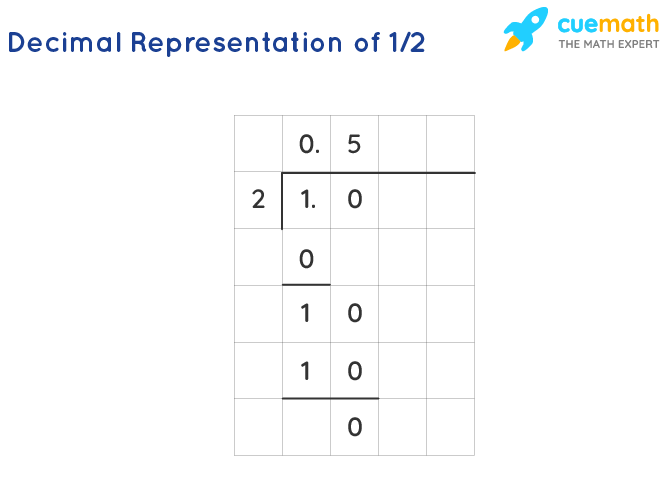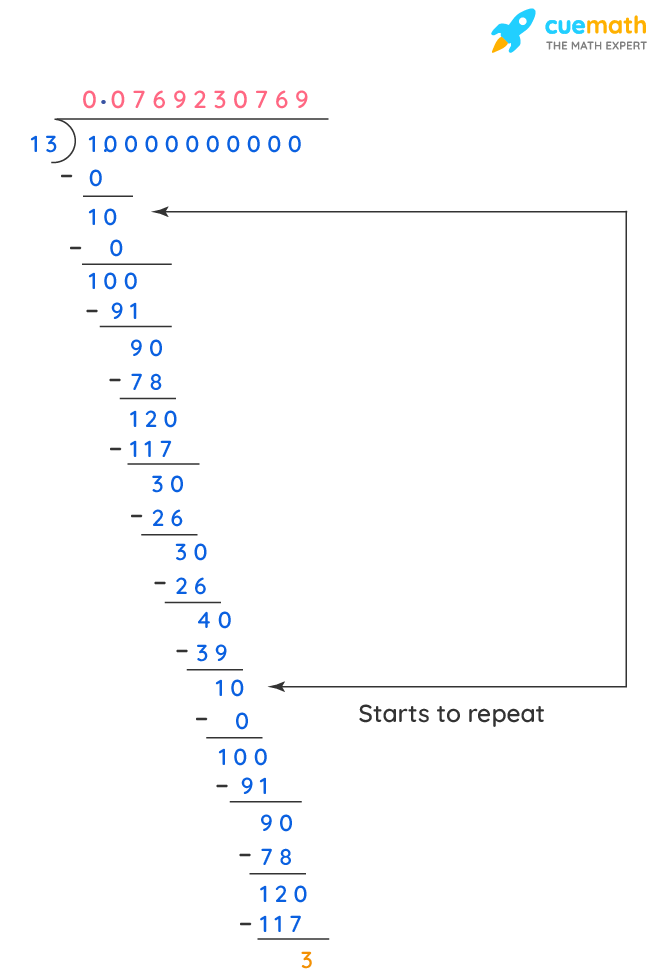Decimal Representation of Rational Numbers
A rational number is a number that can be written in the form p/q where p and q are integers, and q ≠ 0. The set of rational numbers is denoted by Q or \(\mathbb{Q}\). Examples:1/4, −2/5, 0.3 (or) 3/10, −0.7(or) −7/10, 0.151515... (or) 15/99. Rational numbers can be represented as decimals. The different types of rational numbers are Integers like -1, 0, 5, etc., fractions like 2/5, 1/3, etc., terminating decimals like 0.12, 0.625, 1.325, etc., and non-terminating decimals with repeating patterns (after the decimal point) such as 0.666..., 1.151515..., etc.
Decimal Representation of Rational Numbers
The decimal representation of a rational number is converting a rational number into a decimal number that has the same mathematical value as the rational number. A rational number can be represented as a decimal number with the help of the long division method. We divide the given rational number in the long division form and the quotient which we get is the decimal representation of the rational number. A rational number can have two types of decimal representations (expansions):
- Terminating
- Non-terminating but repeating
Note: Any decimal representation that is non-terminating and non-recurring, will be an irrational number.
Let's try to understand what are terminating and non-terminating terms. While dividing a number by the long division method, if we get zero as the remainder, the decimal expansion of such a number is called terminating.
Example: 1/2
Let us see the long division of 1 by 2 in the following image:

1/2 = 0.5 is a terminating decimal
And while dividing a number, if the decimal expansion continues and the remainder does not become zero, it is called non-terminating.
Example: 1/3
Let us see the long division of 1 by 3 in the following image:

1/3 = 0.33333... is a recurring, non-terminating decimal. You can notice that the digits in the quotient keep repeating.
Decimal Representation of Terminating Rational Number
The terminating decimal expansion means that the decimal representation or expansion terminates after a certain number of digits. A rational number is terminating if it can be expressed in the form: p/(2n×5m). The rational number whose denominator is a number that has no other factor than 2 or 5, will terminate the result sooner or later after the decimal point. Consider the rational number 1/16.

Here, the decimal expansion of 1/16 terminates after 4 digits. Here 16 in the denominator is 16 = 24. Note that in terminating decimal expansion, you will find that the prime factorization of the denominator has no other factors other than 2 or 5.
Decimal Representation of Non-Terminating Decimal Number
The non-terminating but repeating decimal expansion means that although the decimal representation has an infinite number of digits, there is a repetitive pattern to it. The rational number whose denominator is having a factor other than 2 or 5, will not have a terminating decimal number as the result.
For example:

Note that in non-terminating but repeating decimal expansion, you will find that the prime factorization of the denominator has factors other than 2 or 5.
Related topics:
Important Notes
- If a number can be expressed in the form p/(2n×5m) where p ∈ Z and m,n ∈ W, then the rational number will be a terminating decimal.
- Terminating decimal expansion means that the decimal representation or expansion terminates after a certain number of digits.
- Every non-terminating but repeating decimal representation corresponds to a rational number even if the repetition starts after a certain number of digits.
Solved Examples
-
Example 1:
Express 1/13 in decimal form.
Solution:
Let's divide 1 by 13.
See the following image for the complete process of division of 1 by 13.

We see that the quotient is 0.0769230769...which is a recurring decimal quotient.
Answer: \(\begin{align} \frac{1}{13} = 0.\overline{076923} \end{align}\)
-
Example 2:
Determine if 11/25 is a terminating or a non-terminating number.
Solution:
A rational number is terminating if it can be expressed in the form:
p/(2n×5m)
The prime factorization of 25 is 5×5
11/25=11/(20×52)
Answer: 11/25 is a terminating rational number.

Frequently Asked Questions(FAQs)
Is a Decimal a Rational Number?
Any decimal number can be either a rational number or an irrational number, depending upon the number of digits and repetition of the digits. Any decimal number whose terms are terminating or non-terminating but repeating then it is a rational number. Whereas if the terms are non-terminating and non-repeating, then it is an irrational number.
How Do You Know if a Decimal is Rational?
We can know a decimal number is rational or not by various methods. We can if a decimal number can be expressed in the form p/q and q ≠ 0, then it is a rational number. Example: 0.25 = 25/100 is a rational number. Or we can check the number of terms and repetition of the terms to know if it a rational number or not. For example, 0.33333... is a rational number.
What are the Characteristics of a Rational Number When Written as a Decimal?
When expressing a rational number in the decimal form, it can be terminating or non-terminating but repeating and the digits can recur in a pattern. Example: 1/2= 0.5 is a terminating decimal number. 1/3 = 0.33333... is a non-terminating decimal number with the digit 3, repeating.
If it is non-terminating and non-recurring, it is not a rational number. Example: π is an irrational number since it has a value that is non-terminating and non-recurring.
Is Every Decimal Number Represented as a Rational Number?
No, every decimal number can not be represented as a rational number. Non-terminating and non-repeating digits to the right of the decimal point cannot be expressed in the form p/q hence they are not rational numbers. But other than these terms, all terms can be represented as a rational number or in the form of p/q.
Is 3.14 a Rational Number?
A rational number is a number that can be written as a fraction, a/b where a and b are integers, or that has terminating or non-terminating but repeating terms. Hence, the number 3.14 is a rational number, since it has terminating terms after the decimal point. If it would have has further terms extending to infinity, it would have been called an irrational number. An irrational number cannot be expressed in the form of p/q It has endless non-repeating digits after the decimal point. Examples: π = 3.141592..., √2=1.414213…
What Cannot be the Decimal Representation of a Rational Number?
A decimal number, that has infinite terms where terms are not repeating itself, then it can not be a decimal representation of a rational number. For a decimal number to be the decimal representation of a rational number, it should have terminating, or non-terminating but repeating terms.
How Do You Find the Decimal Expansion of a Rational Number?
The decimal expansion of a rational number can easily be found out by using the long division or by simply writing the rational number in the form of p/q also known as a fraction form. To convert fractions to decimals, just divide the numerator by the denominator. As it is a rational number, we will get a result that is either terminating or non-terminating but repeating. If the denominator is of the form (2n×5m), then the decimal is sure to terminate, or otherwise, it would repeat with a recurring pattern.
visual curriculum
